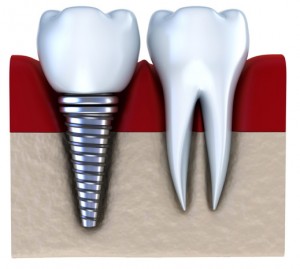 Dental implants have an over 99% success rate when placed by experienced and trained oral surgeons. However, failures can happen. The most common type of dental implant failure is known as non-integration. Implants normally heal by integrating into the surrounding bone as bone cells grow into the surface of the implant and bind to it biologically and mechanically. In very rare instances, soft tissue cells migrate between the bone and the implant surface, effectively blocking their contact. This results in a soft tissue interface leading to a non-bony integration. Clinically, the implant becomes mobile and painful when pressed. This is not a rejection; rather a non-integration healing. Common causes of non-integration are poor surgical techniques, over-preparation of the bone, ‘burning’ of the bone during surgery, and early loading in inappropriate situations.
Dental implants have an over 99% success rate when placed by experienced and trained oral surgeons. However, failures can happen. The most common type of dental implant failure is known as non-integration. Implants normally heal by integrating into the surrounding bone as bone cells grow into the surface of the implant and bind to it biologically and mechanically. In very rare instances, soft tissue cells migrate between the bone and the implant surface, effectively blocking their contact. This results in a soft tissue interface leading to a non-bony integration. Clinically, the implant becomes mobile and painful when pressed. This is not a rejection; rather a non-integration healing. Common causes of non-integration are poor surgical techniques, over-preparation of the bone, ‘burning’ of the bone during surgery, and early loading in inappropriate situations.
The other common type of failure is infection which although rare, can occur with any type of of surgery. Once an implant is infected, its surface becomes contaminated leading to extremely poor prognosis. Antibiotic therapy is ineffective in managing most infected dental implants.
Some dentists elect to ‘watch’ such failing implants in the hope that they will eventually heal and get better. After all, no one likes to experience failure and giving such bad news to a patient is difficult. The fact is, once an implant has undergone non-integration healing or infection, there is nothing that can improve its health. Allowing more time and simply ‘watching them’ only prolongs the problem, promoting further destruction of the bone and more complications.
As soon as a dental implant is diagnosed as non-integrated or infected, it must be removed. The site should be cleaned out and allowed to heal for two to three months before attempting another implant placement. In some circumstances, bone grafting may be necessary to redevelop the implant site. With proper techniques and tissue management, replacement of failed implants can be quite successful. While it requires additional treatment time and surgeries, it remains the superior treatment option to bridges or dentures.
When rare failures happen with dental implants, it’s best to act quick, remove the failing implants, take a deep breath, and replace it properly.